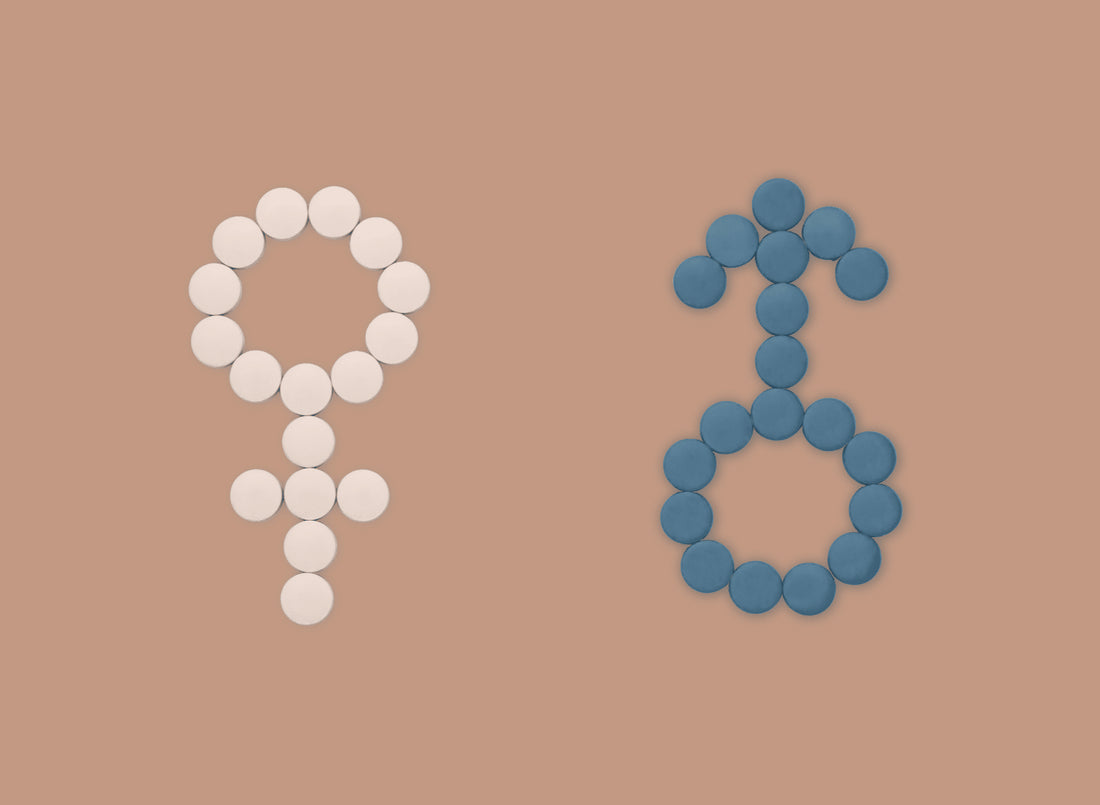SEX HORMONES 101


Many of us think of the sex hormones as being involved primarily in libido and reproduction. While hormones are crucial for sexual arousal and reproductive function, the truth is they do so much more! Read on for an overview of the sex hormone system, causes of hormone imbalances, and what you can do to support hormone balance.
What Is The Sex Hormone System?
The sex hormone system consists of the hormones pregnenolone, DHEA, estrogen, progesterone, and testosterone which act as chemical messengers transmitting unique signals and binding to hormone receptors which exist in many cells and tissues throughout the body. Sex hormones are made by specialized tissues called “glands,” which include the ovaries in women and the testes in men. In addition, the adrenal glands produce the sex hormones DHEA and pregnenolone in both men and women and as we age, the adrenals can also produce small amounts of estrogen and progesterone. Sex hormones regulate critical aspects of development, puberty, reproductive function, and brain, bone, and metabolic health.
All sex hormones are also steroid hormones and biosynthesized from the lipid-based molecule cholesterol in a process called steroidogenesis.
Let’s discuss each of these primary sex hormones and some of their essential functions:
Pregnenolone
Pregnenolone is known as the “mother hormone” because it is the precursor hormone that can be made into all the other sex hormones. Pregnenolone is produced in the brain, adrenal glands, skin, testicles, ovaries, and retina. It facilitates the balanced production of all steroid hormones. Pregnenolone is well known for its neurological benefits and how it influences memory processes and supports healthy brain aging. (1)
DHEA
Dehydroepiandrosterone (DHEA) is an androgenic hormone secreted by the adrenal glands, ovaries, testes, and brain. As an androgen hormone, it supports energy, strength, and libido. DHEA production peaks between the ages of 25 and 30 and begins to decline after that. Physical and emotional stress and blood sugar dysregulation may lower DHEA levels. (2 , 3 ) Conversely, optimal DHEA levels are associated with blood sugar balance, immune function, inflammatory balance, bone health in women, brain function, and healthy aging. (4 , 5 , 6 , 7 ) It also has been found to improve skin health and libido in older women.
Estrogen
Estrogen is a primary sex hormone for women and tertiary sex hormone for men. Produced primarily in the ovaries, adrenals, and placenta, it can also be made from testosterone through a process called aromatization. The estrogen “family,” including estriol, estradiol, and estrone, playing roles in the female reproductive system, mood, energy expenditure, skeletal integrity, and brain health. (8)
Progesterone
Like estrogen, progesterone plays a crucial role in female reproductive health. Progesterone is synthesized in the placenta, ovaries, adrenal glands, brain and nerve cells and is necessary for fertility and the maintenance of pregnancy. ( 9 ) It also helps ease symptoms of heavy and painful periods, promoting healthy menstrual cycles, and can help lessen premenstrual symptoms as well. ( 10 )
Progesterone also has many effects outside of the reproductive system. It mediates adaptation and resistance to stress and helps the body rebound from stressful events. ( 11 ) It also promotes restful sleep, which we all know is necessary for a balanced stress-response system! ( 12 ) Progesterone has also been shown to support the brain by aiding mood and cognition, benefit cardiovascular function by supporting healthy blood pressure, and positively impacting the skeletal systems by keeping joints healthy and supporting bone formation. ( 13 , 14 , 15 )
Testosterone
While testosterone is considered the quintessential “male” hormone, both men and women have testosterone in circulation with levels being significantly higher in men. In women, testosterone is synthesized from DHEA and produced by the ovaries, adrenal glands, and adipose tissue. Low testosterone levels are associated with changes in libido, mood, and body composition in both men and women. Too much testosterone can adversely affect blood sugar in women, while too little testosterone lowers libido and triggers lethargy and muscle weakness in both men and women.
What Is A “Hormone Imbalance?”
A hormone imbalance occurs when there is either too much or too little of certain hormones in the body. Here are a few examples of common sex hormone imbalances:
- Estrogen dominance/progesterone insufficiency: This is a common pattern in our modern-day society, where exposure to toxins like plastics, fertilizers, and more can act as endocrine disrupting chemicals (EDCs), increasing estrogen levels in the body and inhibiting estrogen detoxification, while ongoing stress simultaneously depletes progesterone. Estrogen dominance can result in symptoms such as heavy periods, breast tenderness, premenstrual symptoms, and uterine fibroids. Estrogen dominance and progesterone insufficiency can also occur during perimenopause, when the ovarian production of estrogen fluctuates wildly for some time before ultimately declining permanently in menopause.
- Estrogen dominance/androgen deficiency (in men): A relative dominance of estrogen and depletion of the androgens testosterone and DHEA can occur in men. Exposure to EDCs ( 16 ), stress, poor gut health ( 17 ), an unhealthy diet high in processed carbohydrates and polyunsaturated fats ( 18 ), and excess body fat can all contribute to estrogen dominance and low androgen levels in men. Excess body fat can raise estrogen in men by stimulating aromatase, an enzyme that converts androgens into estrogen
Low testosterone (in men): Low testosterone in men also occurs naturally as part of the aging process due to a loss of Leydig cells in the testes. The Leydig cells are the primary source of testosterone and androgens in men. (19) Low testosterone can contribute to symptoms such as erectile dysfunction and low libido. However, it can also be the prelude to more serious long-term health issues, such as coronary artery disease (CAD). (20)
- Low estrogen: ow estrogen can occur in cycling women under stress, as well as menopausal women due to the loss of ovarian estrogen production. Symptoms of low estrogen in women include fatigue, weight gain, hair loss, poor mood, dry skin, and vaginal dryness. In addition, low estrogen can be caused by under-eating, stress, and a vegan diet (because vegan diets tend to be very low in the nutrients the body needs to synthesize estrogens, such as cholesterol, vitamin A, and zinc), or cessation of ovarian estrogen production in menopause.
- Low DHEA and/or low pregnenolone: DHEA and pregnenolone are both considered “youth” hormones, and their levels drop significantly as we age. Stress can also deplete both hormones. Symptoms of low DHEA and pregnenolone are similar and include sexual dysfunction, low mood, fatigue, and slow memory and processing capabilities.
4 Tips To Address Hormone Imbalances
Many of the same diet and lifestyle strategies that support general health across the lifespan can also help correct hormone imbalances. Practical interventions for balancing hormones include:
- Eat a whole-food-based, nutrient-dense diet. Eat plenty of protein, dietary fats, and avoid eating too many carbohydrates.
- Sleep for 7-9 hours a night. Sleep disturbances adversely impact circadian rhythms and sleep quality, so it’s essential to be intentional about our “sleep hygiene,” such as avoiding blue light exposure at night and making sure we’re sleeping enough.
- Get some sun exposure! UVB light, one of the wavelengths of light we get from the sun, stimulates the skin-brain-gonad axis, increasing testosterone synthesis. (21) Try to get 15-20 minutes of sunlight on your skin daily.
- Lift heavy weights twice a week. By increasing skeletal muscle mass and strength, this strategy supports testosterone synthesis and insulin sensitivity, which declines during the perimenopausal and postmenopausal years. In fact, weight training has been found to prevent weight gain and detrimental changes in body composition (loss of muscle, increased body fat) in postmenopausal women on hormone replacement therapy. (22)
Our sex hormones work wonders for our bodies, far beyond libido and reproduction. However, these hormones can become imbalanced from a variety of inputs, including the natural aging process. It helps to understand how these vital hormones work within the body and to be mindful of imbalances. There are plenty of simple lifestyle modifications to try to get your hormones back on track!


